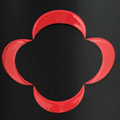Murganheira
by
Terry Sullivan
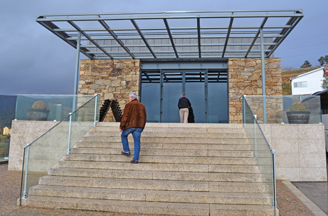 Summary: Nestled in the countryside of the Távora-Varosa DOC, Murganheira produces a wide range of sparkling wines and still wines. The tasting room is welcoming and abounds with creative use of chapitas (placas) and various works of art.
Summary: Nestled in the countryside of the Távora-Varosa DOC, Murganheira produces a wide range of sparkling wines and still wines. The tasting room is welcoming and abounds with creative use of chapitas (placas) and various works of art.
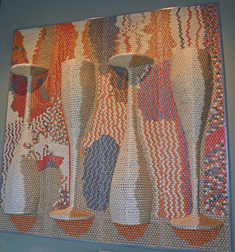 We arrived at the winery on a cool, rainy day in mid-March. While waiting in the tasting room area, we ambled past the displays of art. The one that caught most of our attention was a 3-dimensional display of sparkling wine flutes made from chapitas (placas). The colorful piece of art reminded us to keep the chapitas for future creative endeavors. Another intriguing display was a wine bottle made from colorful discs. The bottle was reminiscent of a Fisher-Price Rock-a-Stack.
We arrived at the winery on a cool, rainy day in mid-March. While waiting in the tasting room area, we ambled past the displays of art. The one that caught most of our attention was a 3-dimensional display of sparkling wine flutes made from chapitas (placas). The colorful piece of art reminded us to keep the chapitas for future creative endeavors. Another intriguing display was a wine bottle made from colorful discs. The bottle was reminiscent of a Fisher-Price Rock-a-Stack.
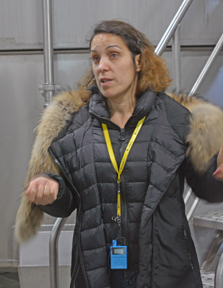 Our host and winemaker, Marta Lourenco arrived and began a tour of the extensive facility. During our stroll, Marta explained that the company was founded in 1946. Although they own 30 hectares (74 acres) of grapes, they source grapes from other growers. Murganheira oversees 1,000 hectares (2,471 acres) of grapes in the Varosa Valley. Marta explained, “The vineyards are a magical place. Soil, temperature and weather all come together to produce wonderful grapes.” A sloping vineyard next to the winery is planted with Cerceal grapes. During a March visit, one can observe post-pruning vine architecture.
Our host and winemaker, Marta Lourenco arrived and began a tour of the extensive facility. During our stroll, Marta explained that the company was founded in 1946. Although they own 30 hectares (74 acres) of grapes, they source grapes from other growers. Murganheira oversees 1,000 hectares (2,471 acres) of grapes in the Varosa Valley. Marta explained, “The vineyards are a magical place. Soil, temperature and weather all come together to produce wonderful grapes.” A sloping vineyard next to the winery is planted with Cerceal grapes. During a March visit, one can observe post-pruning vine architecture.
We stopped outside the press room where there were three presses. The largest has a capacity of pressing 8 tons of grapes while the other two can press four tons each.
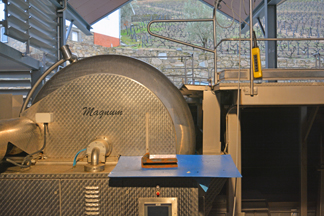 Marta talked about her philosophy of handling the grapes for juice used in making sparkling wines. When pressing grapes, the winery presses the grapes four times, collecting the juice after each pressing. The first press includes the free-run juice and light pressing pressure. The juice generated from the first press is used to wash the grapes. The second pressing is the cuvee and used for creating brut sparkling wines. Juice from the third press is used to craft other sparkling wines. Juice from the fourth press is used for brandy production. Marta mentioned that she has the freedom to decide how much juice can be extracted from each pressing.
Marta talked about her philosophy of handling the grapes for juice used in making sparkling wines. When pressing grapes, the winery presses the grapes four times, collecting the juice after each pressing. The first press includes the free-run juice and light pressing pressure. The juice generated from the first press is used to wash the grapes. The second pressing is the cuvee and used for creating brut sparkling wines. Juice from the third press is used to craft other sparkling wines. Juice from the fourth press is used for brandy production. Marta mentioned that she has the freedom to decide how much juice can be extracted from each pressing.
Fermentation can last for up to three weeks. After fermentation, the wine is allowed to rest for a few months. Then secondary fermentation takes place in the bottle. We observed one room referred to as a yeast maternity room. Yeast is started in this room from a starter yeast and the yeast is reproduced.
We toured the caves that were made of blue granite. The caves were created by using dynamite to blow out the rock. At 76 meters (about 250 feet) underground, these caves maintain a yearly temperature of 12.7º C (55º F). Throughout the caves, wine bottles rested on their sides. Some sections of bottles created their own works of art with mold growing between the bottles. The 1,500,000 bottles in these caves can age for a few months to as long as 15 years depending on the type of sparkling wine crafted.
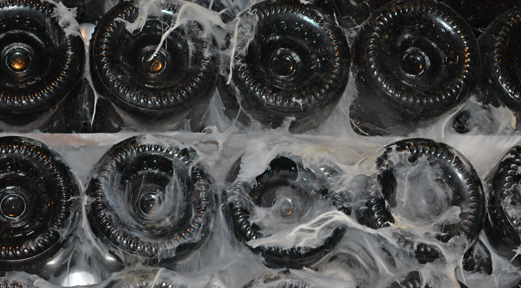
Our tour moved back into the production facility where we observed the riddling process. A woman was riddling bottles on an A-framed riddling rack. She was turning two bottles at a time and completed both sides of a rack in a few minutes. The winery also has gyroplates for riddling the sparkling wines. Marta took us to the area where the bottles are disgorged. She demonstrated disgorging a bottle and was splashed with sparkling wine during the process. Marta then took the tool to remove the cap and repeatedly struck the side of the bottle. A column of sparking wine shot out of the bottle to everyone’s delight.
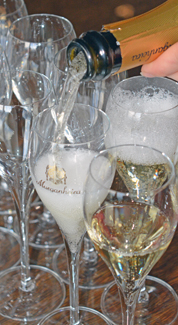 Sparkling Wines
Sparkling Wines
In the tasting room we tasted two sparkling wines. The Malvasia Finã Bruto, Távora-Varosa DOC, was a yellow color and had 6 grams of sugar per liter added for the dosage. The wine in a flute had multiple columns of tiny bubbles forming a center mousse on the wine’s surface. The aroma was floral. The taste included a soft mouth feel and had apple and citrus notes. The wine had a dry, crisp finish. This sparkling wine would make a good aperitif or paired with seafood.
Our second sparkling wine was a 2002 Grande Reserva Bruto, Távora-Varosa DOC. This sparkling wine was very dry with zero grams of sugar per liter. The wine was comprised with a blend of Touriga Nacional, Malvasia Finã and Cerceal grapes. There were multiple columns of tiny bubbles forming a center mousse on the wine’s surface. The aroma and taste offered apple and mineral and there was a lively mouthfeel. The finish was crisp and very dry. This sparkling wine called for food.
If traveling to Porto and the Douro, take a side trip to Murganheira for some sparkling wines and discover what the Távora-Varosa DOC has to offer. Murganheira also crafts still wines which the winery’s website refers to as “tranquil wines”.
Murganheira
Lugar Abadia Velha, Ucanha, Viseu, Portugal
Article written March 2018.
Please support the following.
 |
||||
|
Portugal |
Spain and Portugal |
SmoothRed London, England, United Kingdom |
